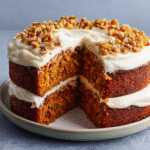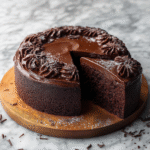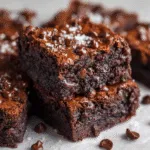Carrot cake is one of those timeless desserts that feels comforting, festive, and surprisingly versatile. From holiday dinners to everyday treats, it has a way of making any occasion feel special. But if you’ve ever made carrot cake from scratch, you know it often means lots of bowls, extra steps, and way too much cleanup.
Enter the One-Bowl Carrot Cake: a recipe designed to give you all the flavor, moisture, and irresistible texture of classic carrot cake without the hassle. This approach is perfect for busy home bakers, parents who want something quick, or anyone who loves baking but doesn’t want to spend hours in the kitchen.
In this guide, we’ll cover everything you need to make the perfect one-bowl carrot cake: from ingredients and step-by-step instructions to storage tips, variations, and pro secrets. By the end, you’ll have a foolproof dessert that’s not only easy but also remarkably delicious.
Why Choose a One-Bowl Carrot Cake?
Saves You Time and Effort
One of the biggest reasons bakers love the one-bowl carrot cake is the time-saving factor. Traditional carrot cake recipes usually ask you to sift, whisk, and combine ingredients across two or even three different bowls. That means more dishes to wash and more steps to manage. With the one-bowl method, everything is combined in a single mixing bowl. The result? Fewer dishes, less cleanup, and a cake that’s ready for the oven in minutes.
Perfect for Beginners
If baking isn’t usually your strong suit or you’re just getting started, this recipe will feel like a lifesaver. The steps are clear, the ingredients are basic and easy to track down, and the method couldn’t be more straightforward. Even someone making carrot cake for the very first time can end up with a soft, moist result that looks like it came from a bakery. It’s one of the most beginner-friendly carrot cake recipes you’ll ever come across.
For another easy dessert idea, check out this One-Bowl Vanilla Sheet Cake.
Ingredients for One-Bowl Carrot Cake
The key to a truly moist carrot cake lies in choosing the right mix of staple and optional ingredients. With the one-bowl method, you’ll be surprised at how quickly everything comes together.
Essential Ingredients
These are the core ingredients that make up a classic one-bowl carrot cake recipe:
- Carrots – Freshly shredding your own carrots is key. They add natural sweetness, extra moisture, and a bright orange hue that makes the cake shine. Store-bought pre-shredded carrots fall short because they’re usually too dry.
- All-purpose flour – This is what gives the cake its form and structure. For a gluten-free version, a 1:1 flour blend can easily be swapped in without affecting the outcome.
- Sugar – Using both white sugar and brown sugar creates the perfect balance, adding sweetness along with a subtle caramel flavor.
- Eggs – Work as the binding agent in the batter, while also contributing richness and a smooth texture.
- Oil – Neutral oils like canola or vegetable keep the cake tender and prevent it from drying out.
Step-by-Step Instructions
Making a one-bowl carrot cake is refreshingly simple. With just one mixing bowl and a few pantry staples, you’ll have a cake that’s moist, flavorful, and ready in no time. Follow these steps for the best results:
Mixing the Batter
- Oven and pan – Heat the oven to 350°F (175°C). Lightly grease a square or round cake pan, then place parchment paper on the bottom to ensure the cake comes out easily.
- Wet mixture – In a large bowl, beat the eggs with the oil and both sugars until the mixture looks smooth, glossy, and slightly thick.
- Carrots – Fold in the freshly grated carrots. They infuse moisture, subtle sweetness, and color throughout the batter.
- Add the dry ingredients – Sift in the flour, baking powder, baking soda, cinnamon, and nutmeg. Gently fold until just combined. Be careful not to overmix, so the cake bakes up soft and fluffy.
Baking the Cake
Scoop the prepared batter into the cake pan and smooth the surface with a spatula to ensure even baking.
Bake – Slide the pan onto the middle rack and let it bake for 35–40 minutes. You’ll know it’s perfectly done when the top springs back at a light touch and a toothpick inserted in the center comes out clean and crumb-free.
Cool completely – Allow the cake to rest in the pan for about 10 minutes, then move it to a wire rack. Let it cool fully before frosting to prevent the topping from melting or slipping off.
Print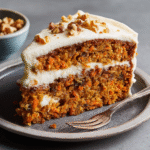
One-Bowl Carrot Cake Recipe
- Total Time: 50 minutes
- Yield: 12 servings
Description
This One-Bowl Carrot Cake is a moist, warmly spiced, mix-and-bake classic that comes together quickly with minimal cleanup. Everything whisks up in a single bowl, bakes to tender perfection, and finishes with tangy cream cheese frosting—great for weeknights, holidays, or anytime you want an easy dessert that everyone loves.
Ingredients
- 2 cups (260g) all-purpose flour
- 1 1/2 teaspoons baking powder
- 1 teaspoon baking soda
- 1/2 teaspoon fine salt
- 2 teaspoons ground cinnamon
- 1/4 teaspoon ground nutmeg
- 1 cup (200g) granulated sugar
- 1/2 cup (100g) packed light brown sugar
- 3 large eggs, at room temperature
- 3/4 cup (180ml) neutral oil (canola or vegetable)
- 2 teaspoons pure vanilla extract
- 2 cups (240g) finely grated carrots (freshly grated)
- 1/2 cup crushed pineapple, well drained (optional)
- 1/2 cup chopped walnuts or pecans (optional)
- 1/2 cup raisins (optional)
- Cream Cheese Frosting
- 8 oz (226g) cream cheese, softened
- 6 tablespoons (85g) unsalted butter, softened
- 2 1/2–3 cups (300–360g) powdered sugar
- 1 teaspoon pure vanilla extract
- Pinch of fine salt
- 1–2 tablespoons milk or cream, as needed
Instructions
- Prep: Heat oven to 350°F (175°C). Grease a 9×13-inch pan (or two 8-inch round pans) and line bottoms with parchment.
- Whisk Wet Ingredients: In a large mixing bowl, whisk eggs, oil, granulated sugar, brown sugar, and vanilla until smooth.
- Add Dry Ingredients: Sprinkle flour, baking powder, baking soda, salt, cinnamon, and nutmeg over the bowl. Fold gently until a few streaks of flour remain.
- Fold In Carrots & Mix-ins: Stir in grated carrots (and pineapple, nuts, or raisins if using) until evenly combined. Avoid heavy mixing.
- Bake: Spread batter in the prepared pan. Bake 35–40 minutes for a 9×13 (25–30 minutes for 8-inch rounds), or until a toothpick in the center comes out clean and the top springs back.
- Cool: Let the cake rest 10 minutes in the pan, then turn out to a rack and cool completely.
- Make Frosting: Beat cream cheese and butter until creamy. Add powdered sugar gradually, then vanilla and a pinch of salt. Splash in milk as needed for a soft, spreadable frosting.
- Frost & Serve: Spread frosting over the cooled cake (or layer and frost the rounds). Garnish with chopped nuts or a light dusting of cinnamon if you like.
Notes
Freshly grated carrots give the best texture—pre-shredded packs tend to be dry. For cupcakes, divide batter into a lined muffin tin and bake 18–20 minutes. To lighten the crumb, swap 1/4 cup oil with applesauce. Store frosted cake covered in the fridge; bring to room temperature before serving for the creamiest bites.
- Prep Time: 15 minutes
- Cook Time: 35 minutes
- Category: Dessert
- Method: Baking
- Cuisine: American
Frosting Options for One-Bowl Carrot Cake

The perfect frosting can elevate a moist carrot cake from simply delicious to absolutely memorable. Cream cheese frosting is the classic go-to, but you can easily adapt it to suit your taste or dietary preferences.
Classic Cream Cheese Frosting
- You’ll need: cream cheese, butter, powdered sugar, and a splash of vanilla extract.
- Method: Beat the cream cheese and butter until smooth and fluffy. Gradually add powdered sugar, then finish with vanilla for flavor.
- Why it works: The tangy cream cheese balances the natural sweetness of the carrots and the warmth of the spices. This is the frosting most people picture when they think of the best carrot cake.
Lighter Alternatives
- Greek yogurt frosting: Combine strained Greek yogurt with a touch of honey and vanilla. It’s creamy, slightly tangy, and far lighter than the traditional version.
- Whipped coconut cream: For a dairy-free option, whip chilled coconut cream with a bit of powdered sugar. It pairs wonderfully with the tropical notes of pineapple or coconut if you’ve added them to your one-bowl carrot cake recipe.
- Simple glaze: A quick mix of powdered sugar and orange juice can create a shiny drizzle that adds sweetness without heaviness.
Storage and Make-Ahead Tips
One of the best things about a one-bowl carrot cake is how well it keeps. With the right storage, you can bake it in advance, frost it later, or even freeze it for future celebrations.
Storing the Cake
- Room temperature: If unfrosted, the cake can stay fresh on the counter in an airtight container for up to two days.
- Refrigerated: Once frosted with cream cheese or yogurt frosting, it’s best to refrigerate. The cake will stay moist and safe to eat for up to five days. Make sure to wrap it securely so it stays moist and doesn’t dry out.
- Serving tip: Always bring the cake to room temperature before serving. A slightly softened frosting makes every bite creamier and more delicious.
Freezing Instructions
- Cake layers – After the cakes have completely cooled, wrap each layer snugly in plastic wrap, then add a layer of foil for extra protection. This seals in freshness, prevents freezer burn, and preserves the flavor for up to three months.
- Frosting – If you plan to make the cream cheese frosting ahead, place it in an airtight container before freezing. Let it thaw overnight in the refrigerator, then whip it again to restore its smooth, creamy texture.
- Quick thaw method – When ready to serve, leave the cake layers at room temperature for 2–3 hours until completely defrosted. Frost only after the cake is fully thawed for the best consistency.
Substitutions and Variations
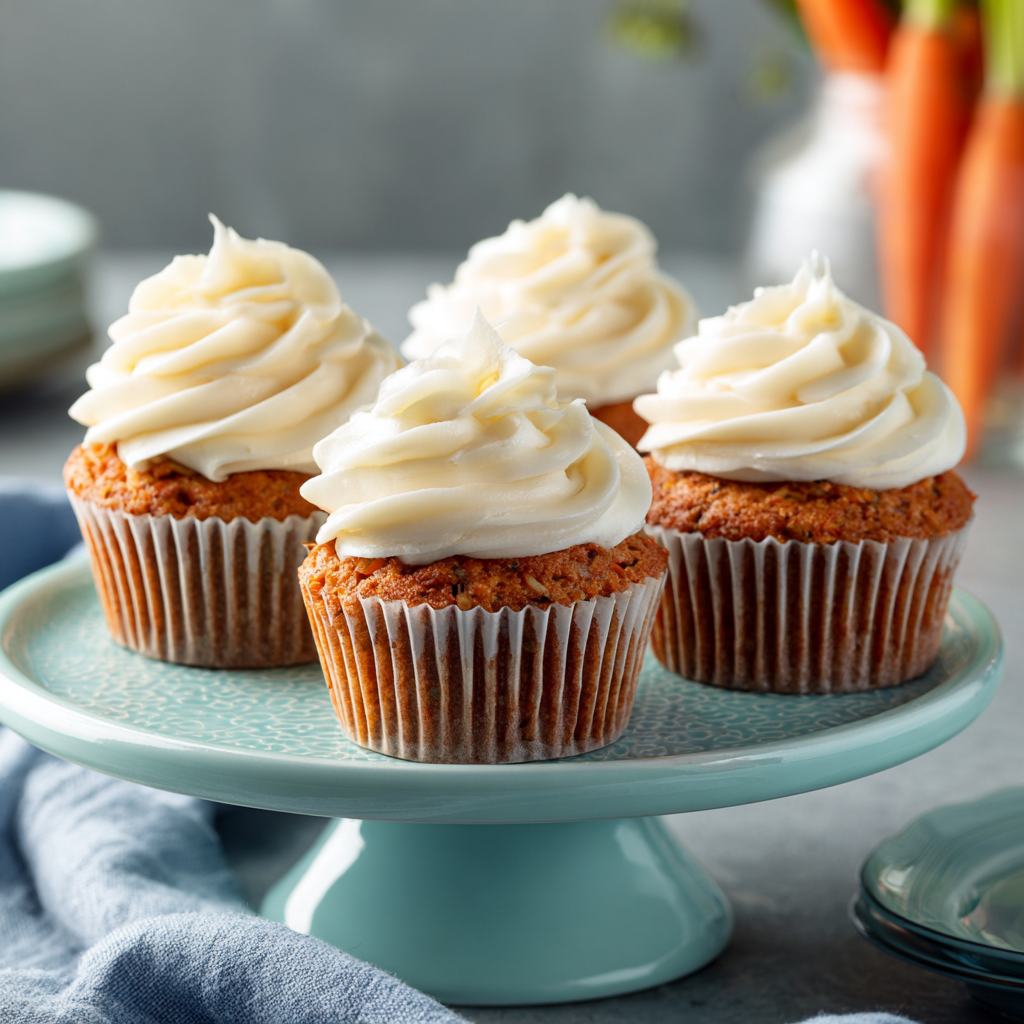
One of the strengths of a one-bowl carrot cake recipe is how flexible it can be. Whether you’re baking for special diets or you simply want to try new flavors, there are plenty of creative swaps and additions.
Dietary Swaps
- Gluten-Free: Swap the all-purpose flour for a 1:1 gluten-free baking mix to make the cake suitable for gluten-free diets. Look for one that includes xanthan gum for structure, so your moist carrot cake doesn’t crumble.
- Vegan: Swap the eggs for flaxseed eggs (1 tablespoon ground flax + 3 tablespoons water per egg). Use dairy-free cream cheese for frosting.
- Reduced Sugar: Try coconut sugar or a mix of sugar and applesauce. These still keep the cake sweet while lowering refined sugar content.
- Lower Fat: Replace some of the oil with unsweetened applesauce or Greek yogurt. The texture stays soft, but with fewer calories.
Flavor Variations
- Tropical twist: Mix in crushed pineapple and a handful of shredded coconut for a bright, island-inspired version of carrot cake.
- Nut-free: Leave out the walnuts or pecans and replace them with extra raisins or dried cranberries for texture without the nuts.
- Cupcake option: Portion the batter into a lined muffin tin and bake for 18–20 minutes. A fun choice for parties or single-serve treats.
- Spice upgrade: Enhance the flavor by adding cardamom, ginger, or allspice along with the cinnamon and nutmeg for a richer spice blend.
Troubleshooting Common Issues
Even experienced bakers can run into a few hiccups when making a one-bowl carrot cake. Below are some of the most frequent issues and simple ways to solve them.
Why is my carrot cake dry?
A moist carrot cake depends on the right balance of oil, carrots, and baking time. If your cake turns out dry:
- Too much flour: Be sure to measure correctly using the spoon-and-level method, not by scooping.
- Not enough oil: Carrot cake needs fat to stay soft. Don’t cut the oil too much.
- Overbaking: Test the cake a few minutes before the timer ends. As soon as the toothpick emerges clean, it’s ready to come out of the oven.
Why did my cake sink in the middle?
A sunken cake can be frustrating, but it usually has a simple cause:
- Overmixing: Mixing too much after adding flour develops excess gluten, which makes the cake collapse.
- Oven door opened too early: Sudden changes in temperature can make the cake deflate. Keep the oven closed until the last 5 minutes.
- Too much leavening: Using extra baking powder or baking soda may cause the cake to rise too quickly and then fall. Measure carefully for a stable rise.
Serving Ideas
A one-bowl carrot cake isn’t just delicious it’s versatile enough to fit into everyday snacking or elegant celebrations. How you serve it can transform this classic dessert into something truly memorable.
Everyday Treats
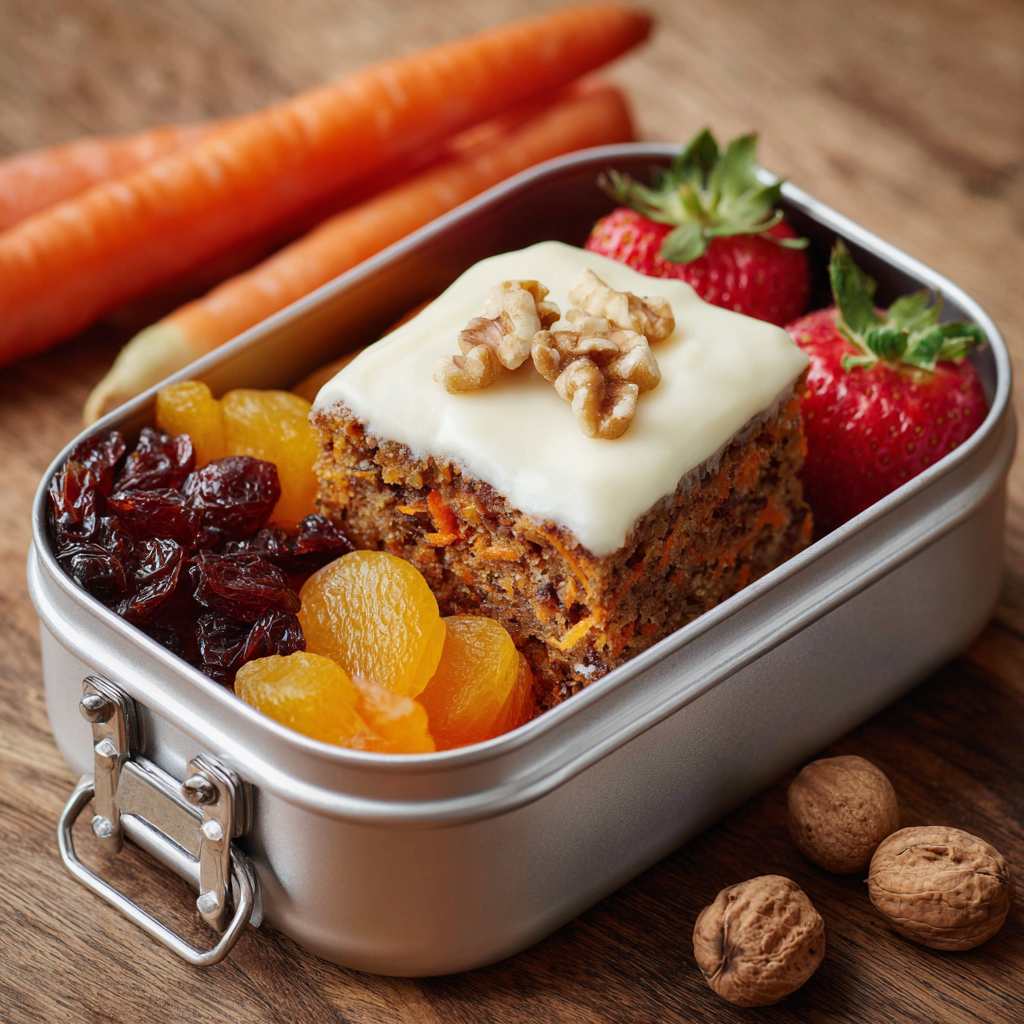
- Afternoon snack: Pair a slice of soft, moist carrot cake with a cup of tea or coffee for a cozy mid-day treat.
- Lunchbox surprise: Cut into squares and pack it for school or work lunches — it holds up well and keeps its flavor.
- Simple glaze: Instead of a full frosting, try a light dusting of powdered sugar or a drizzle of citrus glaze for a quick treat.
Special Occasions
- Birthday cake: Layer your one-bowl carrot cake with cream cheese frosting and decorate with toasted nuts for a festive centerpiece.
- Holiday dessert: This cake shines at Easter, Thanksgiving, or Christmas gatherings. Garnish with edible flowers or candied carrots for an eye-catching touch.
- Cupcake twist: Bake the batter into carrot cake cupcakes and frost with swirls of cream cheese for parties or potlucks.
Nutritional Breakdown
Many people assume that a carrot cake recipe is overly indulgent, but the truth is that it carries some surprising nutritional benefits. With carrots, nuts, and the right swaps, your one-bowl carrot cake can be both satisfying and wholesome.
Healthier Than You Think
- Carrots: Rich in beta-carotene, fiber, and antioxidants, they not only add flavor and texture but also give the cake a wholesome boost.
- Nuts: Walnuts or pecans add protein, omega-3s, and healthy fats, boosting the cake’s nutritional profile.
- Spices: Cinnamon and nutmeg aren’t just for flavor — they have natural anti-inflammatory properties.
- Smart swaps: Using applesauce, coconut sugar, or whole wheat flour can make your moist carrot cake lighter without losing flavor.
Portion Control Tips
- Smaller slices: Cutting modest portions lets you enjoy dessert without overindulging.
- Cupcakes instead of cake: Baking carrot cake cupcakes helps with built-in portioning — and they’re easier to share.
- Balance it out: Pair a slice with fresh fruit or a cup of tea instead of a heavy meal for a more balanced indulgence.
FAQs
Can I make one-bowl carrot cake without nuts?
Yes, absolutely. If you or someone you’re serving has a nut allergy, just leave out the walnuts or pecans. The one-bowl carrot cake recipe will still be moist, flavorful, and perfectly balanced. To keep a bit of texture, you can add extra raisins, shredded coconut, or even sunflower seeds.
Can I turn this carrot cake recipe into cupcakes?
Definitely. Divide the batter evenly into a lined muffin tin and bake at 350°F (175°C) for 18–20 minutes. You’ll end up with carrot cake cupcakes that are light, fluffy, and easy to serve at parties. Top them with cream cheese frosting swirls for a professional bakery look.
What’s the best frosting alternative to cream cheese?
If cream cheese frosting isn’t your go-to, you still have plenty of choices. A classic buttercream gives a sweeter, richer flavor, while whipped coconut cream makes a great dairy-free substitute. For a lighter finish, try an orange glaze — it pairs wonderfully with the warm spices in a one-bowl carrot cake.
Conclusion
The one-bowl carrot cake is proof that baking doesn’t have to be complicated to be delicious. With a single mixing bowl, everyday ingredients, and straightforward steps, you can create a dessert that’s moist, flavorful, and crowd-pleasing every time.
Unlike traditional recipes that require multiple bowls and extra prep, this method keeps things simple — yet the results are just as impressive. From everyday snacks to holiday tables, from sheet cakes to carrot cake cupcakes, this recipe adapts to any occasion.
Whether you stick with the classic cream cheese frosting or try lighter alternatives, this cake delivers consistent flavor and texture that everyone will love. Plus, with the storage tips, dietary swaps, and troubleshooting tricks you’ve learned here, you’re equipped to bake like a pro.
So grab your mixing bowl, grate some fresh carrots, and treat yourself to the joy of baking. Once you’ve tried this easy carrot cake, it’s bound to become a recipe you’ll make again and again.



